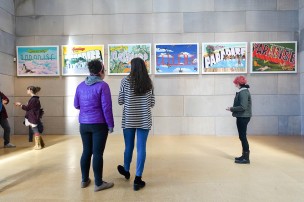Over the course of four weeks, Zilkha Gallery is exhibiting senior art theses that tackle topics from AIDS to Asian stereotypes.
If I could design my own tour of Wesleyan for prospective students, I would begin with the Zilkha Gallery. Currently installed in the sparse, modern space are the works of students who created art for their senior thesis projects.
Divided into four weeks with four to five projects shown each week, the theses act as a testament to how smart, creative, and talented Wesleyan students are. The artists draw inspiration from unexpected sources. One especially captivating exhibition was a multimedia project by Raphael Leitz ’15, which was infused with elements of race car driving.
“Leitz’s impressive investigation of texture and boundaries belongs in a New York City art gallery,” said Carter Deane ’18. “It was original and creative, and it demanded attention from the audience.”
After two semesters of thesis tutorials and close communication with faculty advisors as well as second critics who assess each exhibition, art studio senior theses must pass a vote taken by art studio faculty. The exhibitions, which are strikingly professional and polished, express this thorough process.
Each week’s exhibition has been evenly spread out in the type of art it displays. While many of the projects concentrate on one medium, some—such as the collection of paintings, photographs, and comically enlarged mail by Gabe Gordon ’15—mix different pieces of art. In “mend/unmend,” Hailey Sowden ’15 combined pencil, paper, needles, and other unexpected tools in a collection of pieces ranging in scale from printer paper- to mural-size.
Many of the pieces are interactive and utilize the space of the Zilkha gallery. For “Maze of Strings,” Derrick Wang ’15 attached thin white strings to various walls and corners of the gallery, producing a stunningly symmetrical structure that played off the gallery’s space and invited the viewers to explore the negative space that it created.
In a different interactive piece by Luca Ameri ’15 titled “(Im)mutable Solid,” viewers were encouraged to roam between architectural black structures hanging from the ceiling.
“I was literally and figuratively immersed and surrounded by the culmination of his work,” Allison Gross ’18 said. “It was dope.”
It really is difficult to resist using the word “dope” to describe all of the senior thesis projects. As students, we all bring our own experiences and interests to the table, and these seniors have streamlined their individual perspectives into powerful visual art to share them with the general Wesleyan community.
Between Gordon’s multimedia project about AIDS and how it influences our society and culture, and a commentary on how we perceive the natural world by Genna DeGroot ’15, an incredibly wide palette of interests is being displayed throughout the month.
In the coming weeks, the diversity of projects will remain extensive. Virgil Taylor ’15 is using his thesis as an opportunity to reveal, as he describes, “themes of queerness in Christianity.” He created a series of stained glass windows influenced by “the implicit homoeroticism of the Jesus narrative.”
Sarah Koppelkam ’15, whose thesis will be displayed starting April 14 (during the last round of exhibitions), describes her paintings as “big, loud and overwhelming.” They were inspired by her frustration with “the limitations created by conventions of genre and narrative.”
Despite their diversity, the theses work together in the same gallery because they express a general theme of liberation, breaking freeing of typical definitions, categories, or stereotypes of various kinds. Since three of the exhibitions are displayed in the same room of the gallery, the open space connects the pieces, allowing them to exist separately or to be observed as one large expression of creativity.
Since none of the artists are required to create a plaque about their work (and very few do), the best way to visit the exhibitions is to have a brief conversation with each artist as they roam around near their projects.
Understanding the ideas behind the work reinforces the artists’ talent and creativity, but if you are really pressed for time, simple observation is also an intriguing way to go through the exhibitions. Free from the artists’ own definitions of their work, you may end up interpreting it in a more individualized and unanticipated way.
The third set of theses begins tomorrow, and the last exhibition will go up a week later. I highly recommend going, even if it’s only for the free snacks. You will not be disappointed.
This article has been altered from the print edition.

Comments are closed